Analysis of Business Structures & Directors' Duties - Company Law 401
VerifiedAdded on 2023/06/11
|14
|3053
|133
Report
AI Summary
This report provides an analysis of various business structures, including sole proprietorships, partnerships, companies, trusts, and joint ventures, evaluating their advantages, disadvantages, and tax implications. It suggests that a sole trader structure is most suitable for a new fashion business venture. Furthermore, the report outlines the duties of directors under the Corporations Act 2001, emphasizing the importance of acting with care, diligence, good faith, and proper use of position and information. The analysis covers key sections of the Act, such as sections 180, 181, 182, and 183, and uses case law to illustrate the application of these duties in practice.
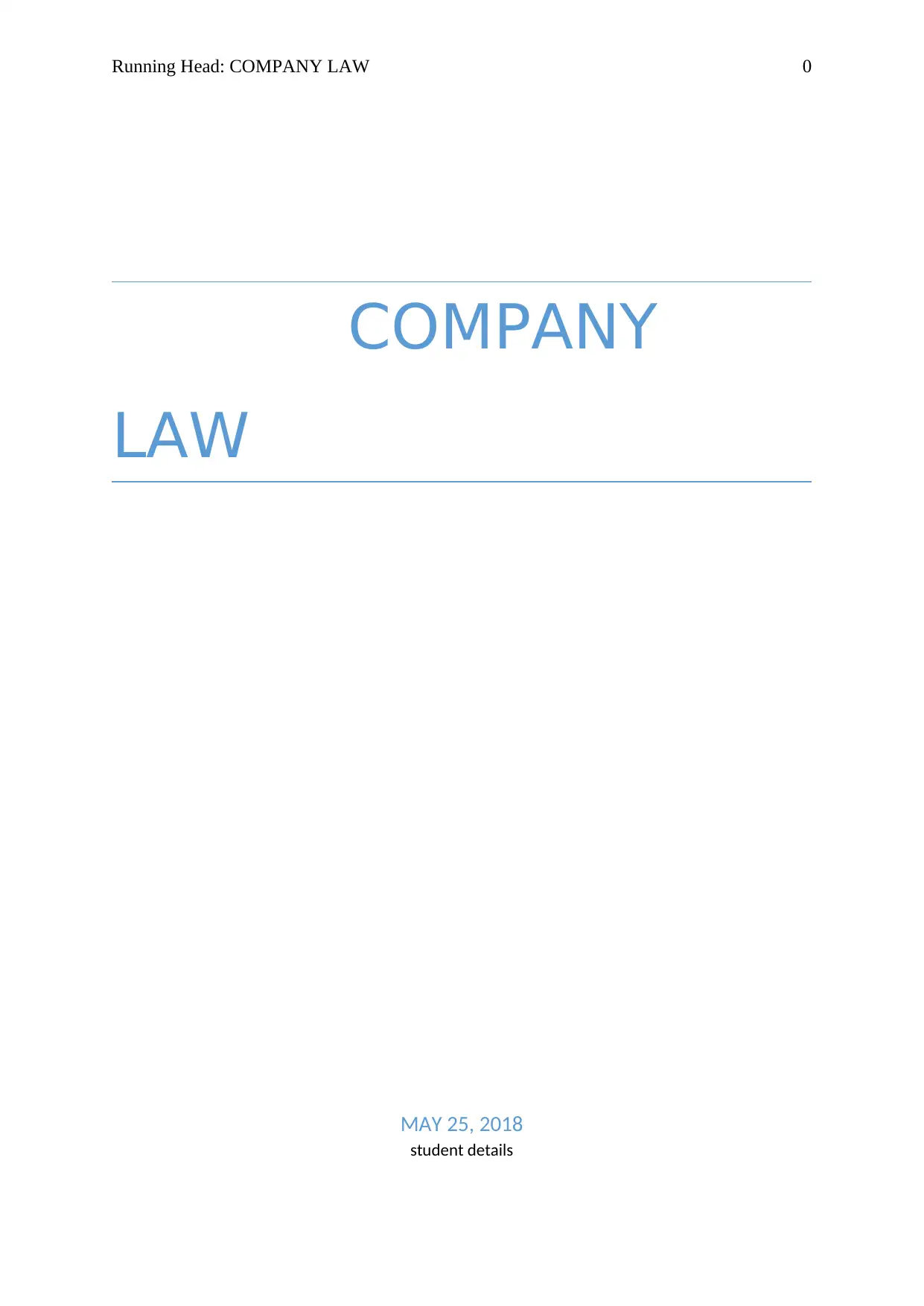
Running Head: COMPANY LAW 0
COMPANY
LAW
MAY 25, 2018
student details
COMPANY
LAW
MAY 25, 2018
student details
Paraphrase This Document
Need a fresh take? Get an instant paraphrase of this document with our AI Paraphraser
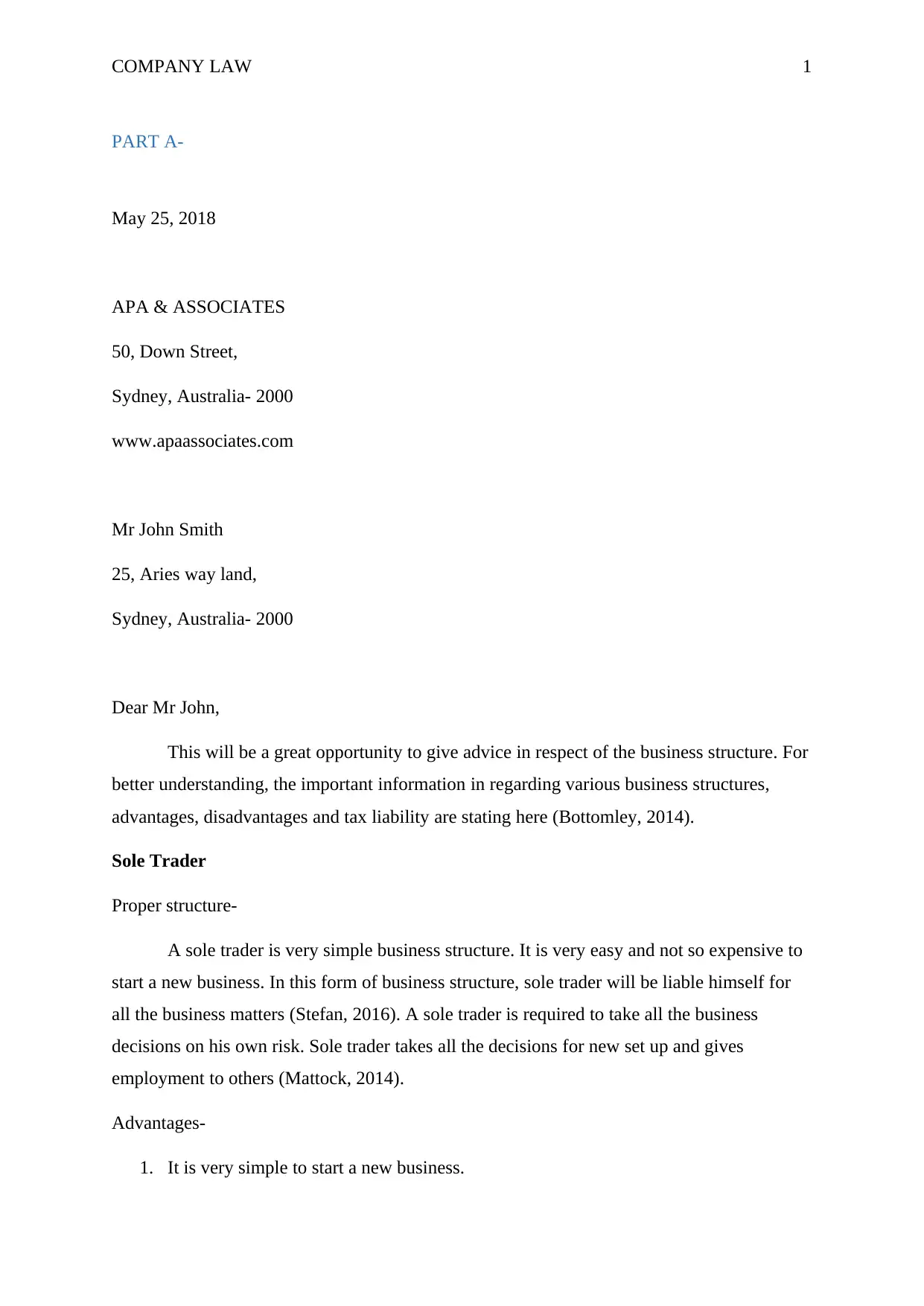
COMPANY LAW 1
PART A-
May 25, 2018
APA & ASSOCIATES
50, Down Street,
Sydney, Australia- 2000
www.apaassociates.com
Mr John Smith
25, Aries way land,
Sydney, Australia- 2000
Dear Mr John,
This will be a great opportunity to give advice in respect of the business structure. For
better understanding, the important information in regarding various business structures,
advantages, disadvantages and tax liability are stating here (Bottomley, 2014).
Sole Trader
Proper structure-
A sole trader is very simple business structure. It is very easy and not so expensive to
start a new business. In this form of business structure, sole trader will be liable himself for
all the business matters (Stefan, 2016). A sole trader is required to take all the business
decisions on his own risk. Sole trader takes all the decisions for new set up and gives
employment to others (Mattock, 2014).
Advantages-
1. It is very simple to start a new business.
PART A-
May 25, 2018
APA & ASSOCIATES
50, Down Street,
Sydney, Australia- 2000
www.apaassociates.com
Mr John Smith
25, Aries way land,
Sydney, Australia- 2000
Dear Mr John,
This will be a great opportunity to give advice in respect of the business structure. For
better understanding, the important information in regarding various business structures,
advantages, disadvantages and tax liability are stating here (Bottomley, 2014).
Sole Trader
Proper structure-
A sole trader is very simple business structure. It is very easy and not so expensive to
start a new business. In this form of business structure, sole trader will be liable himself for
all the business matters (Stefan, 2016). A sole trader is required to take all the business
decisions on his own risk. Sole trader takes all the decisions for new set up and gives
employment to others (Mattock, 2014).
Advantages-
1. It is very simple to start a new business.
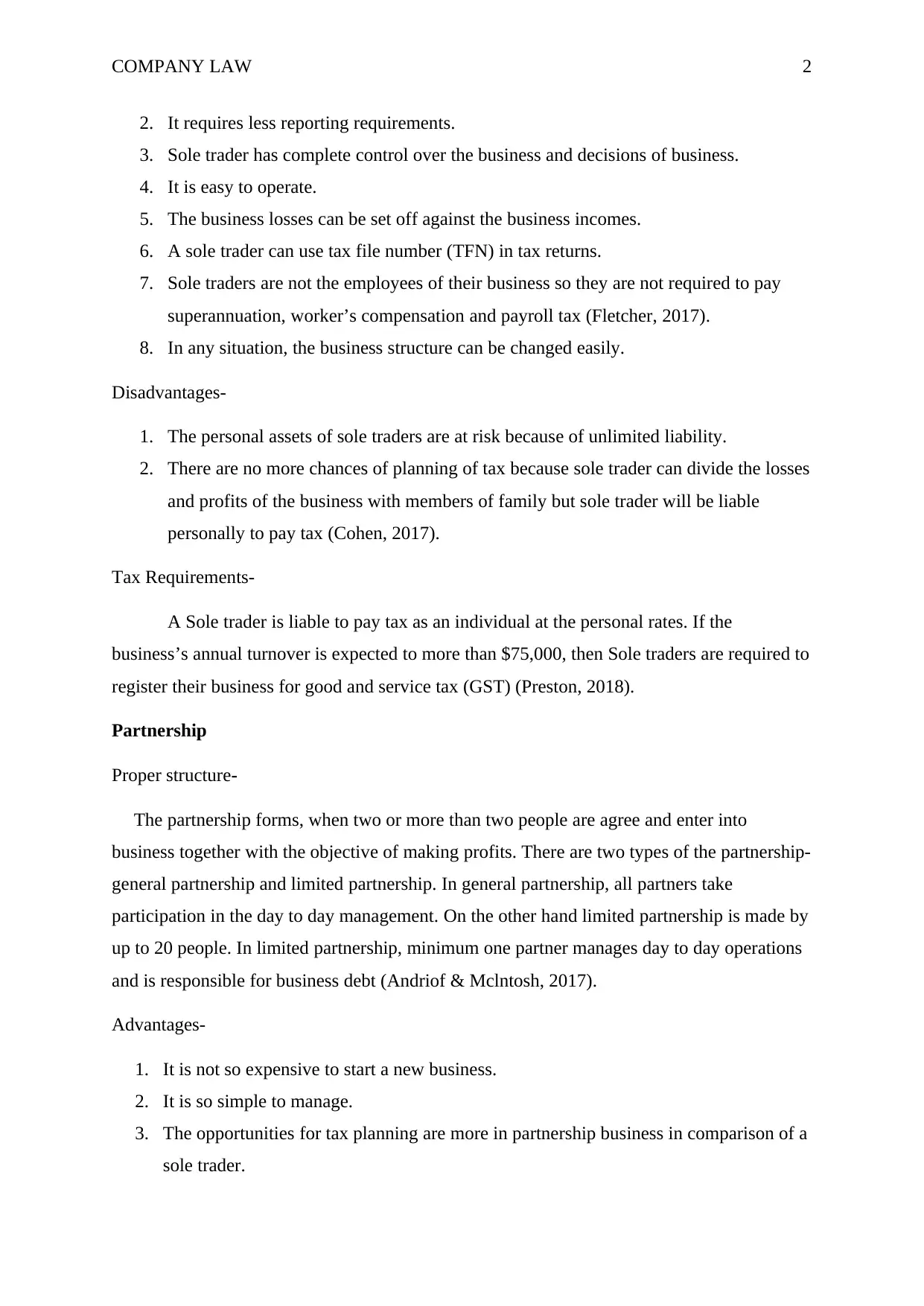
COMPANY LAW 2
2. It requires less reporting requirements.
3. Sole trader has complete control over the business and decisions of business.
4. It is easy to operate.
5. The business losses can be set off against the business incomes.
6. A sole trader can use tax file number (TFN) in tax returns.
7. Sole traders are not the employees of their business so they are not required to pay
superannuation, worker’s compensation and payroll tax (Fletcher, 2017).
8. In any situation, the business structure can be changed easily.
Disadvantages-
1. The personal assets of sole traders are at risk because of unlimited liability.
2. There are no more chances of planning of tax because sole trader can divide the losses
and profits of the business with members of family but sole trader will be liable
personally to pay tax (Cohen, 2017).
Tax Requirements-
A Sole trader is liable to pay tax as an individual at the personal rates. If the
business’s annual turnover is expected to more than $75,000, then Sole traders are required to
register their business for good and service tax (GST) (Preston, 2018).
Partnership
Proper structure-
The partnership forms, when two or more than two people are agree and enter into
business together with the objective of making profits. There are two types of the partnership-
general partnership and limited partnership. In general partnership, all partners take
participation in the day to day management. On the other hand limited partnership is made by
up to 20 people. In limited partnership, minimum one partner manages day to day operations
and is responsible for business debt (Andriof & Mclntosh, 2017).
Advantages-
1. It is not so expensive to start a new business.
2. It is so simple to manage.
3. The opportunities for tax planning are more in partnership business in comparison of a
sole trader.
2. It requires less reporting requirements.
3. Sole trader has complete control over the business and decisions of business.
4. It is easy to operate.
5. The business losses can be set off against the business incomes.
6. A sole trader can use tax file number (TFN) in tax returns.
7. Sole traders are not the employees of their business so they are not required to pay
superannuation, worker’s compensation and payroll tax (Fletcher, 2017).
8. In any situation, the business structure can be changed easily.
Disadvantages-
1. The personal assets of sole traders are at risk because of unlimited liability.
2. There are no more chances of planning of tax because sole trader can divide the losses
and profits of the business with members of family but sole trader will be liable
personally to pay tax (Cohen, 2017).
Tax Requirements-
A Sole trader is liable to pay tax as an individual at the personal rates. If the
business’s annual turnover is expected to more than $75,000, then Sole traders are required to
register their business for good and service tax (GST) (Preston, 2018).
Partnership
Proper structure-
The partnership forms, when two or more than two people are agree and enter into
business together with the objective of making profits. There are two types of the partnership-
general partnership and limited partnership. In general partnership, all partners take
participation in the day to day management. On the other hand limited partnership is made by
up to 20 people. In limited partnership, minimum one partner manages day to day operations
and is responsible for business debt (Andriof & Mclntosh, 2017).
Advantages-
1. It is not so expensive to start a new business.
2. It is so simple to manage.
3. The opportunities for tax planning are more in partnership business in comparison of a
sole trader.
⊘ This is a preview!⊘
Do you want full access?
Subscribe today to unlock all pages.

Trusted by 1+ million students worldwide
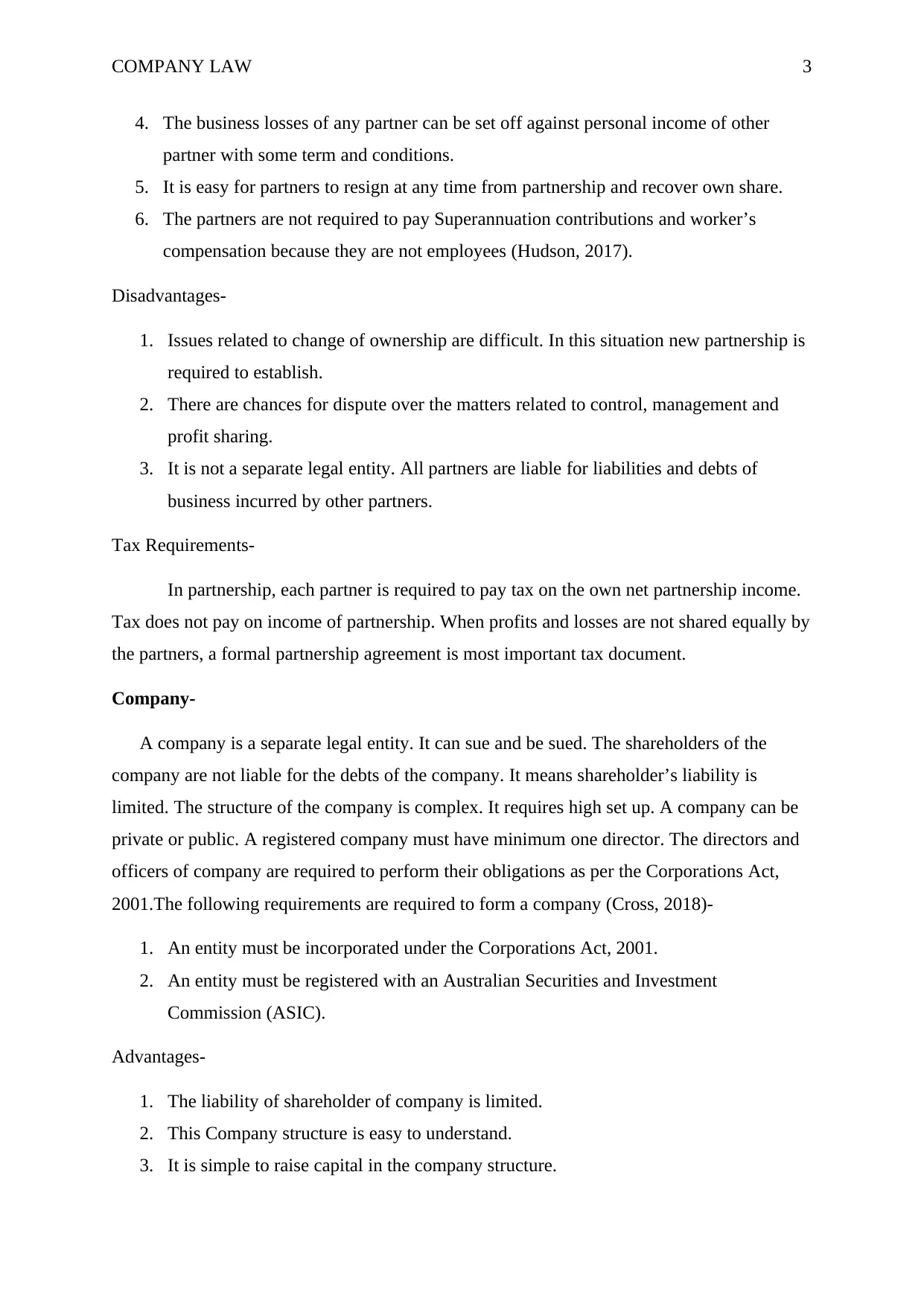
COMPANY LAW 3
4. The business losses of any partner can be set off against personal income of other
partner with some term and conditions.
5. It is easy for partners to resign at any time from partnership and recover own share.
6. The partners are not required to pay Superannuation contributions and worker’s
compensation because they are not employees (Hudson, 2017).
Disadvantages-
1. Issues related to change of ownership are difficult. In this situation new partnership is
required to establish.
2. There are chances for dispute over the matters related to control, management and
profit sharing.
3. It is not a separate legal entity. All partners are liable for liabilities and debts of
business incurred by other partners.
Tax Requirements-
In partnership, each partner is required to pay tax on the own net partnership income.
Tax does not pay on income of partnership. When profits and losses are not shared equally by
the partners, a formal partnership agreement is most important tax document.
Company-
A company is a separate legal entity. It can sue and be sued. The shareholders of the
company are not liable for the debts of the company. It means shareholder’s liability is
limited. The structure of the company is complex. It requires high set up. A company can be
private or public. A registered company must have minimum one director. The directors and
officers of company are required to perform their obligations as per the Corporations Act,
2001.The following requirements are required to form a company (Cross, 2018)-
1. An entity must be incorporated under the Corporations Act, 2001.
2. An entity must be registered with an Australian Securities and Investment
Commission (ASIC).
Advantages-
1. The liability of shareholder of company is limited.
2. This Company structure is easy to understand.
3. It is simple to raise capital in the company structure.
4. The business losses of any partner can be set off against personal income of other
partner with some term and conditions.
5. It is easy for partners to resign at any time from partnership and recover own share.
6. The partners are not required to pay Superannuation contributions and worker’s
compensation because they are not employees (Hudson, 2017).
Disadvantages-
1. Issues related to change of ownership are difficult. In this situation new partnership is
required to establish.
2. There are chances for dispute over the matters related to control, management and
profit sharing.
3. It is not a separate legal entity. All partners are liable for liabilities and debts of
business incurred by other partners.
Tax Requirements-
In partnership, each partner is required to pay tax on the own net partnership income.
Tax does not pay on income of partnership. When profits and losses are not shared equally by
the partners, a formal partnership agreement is most important tax document.
Company-
A company is a separate legal entity. It can sue and be sued. The shareholders of the
company are not liable for the debts of the company. It means shareholder’s liability is
limited. The structure of the company is complex. It requires high set up. A company can be
private or public. A registered company must have minimum one director. The directors and
officers of company are required to perform their obligations as per the Corporations Act,
2001.The following requirements are required to form a company (Cross, 2018)-
1. An entity must be incorporated under the Corporations Act, 2001.
2. An entity must be registered with an Australian Securities and Investment
Commission (ASIC).
Advantages-
1. The liability of shareholder of company is limited.
2. This Company structure is easy to understand.
3. It is simple to raise capital in the company structure.
Paraphrase This Document
Need a fresh take? Get an instant paraphrase of this document with our AI Paraphraser
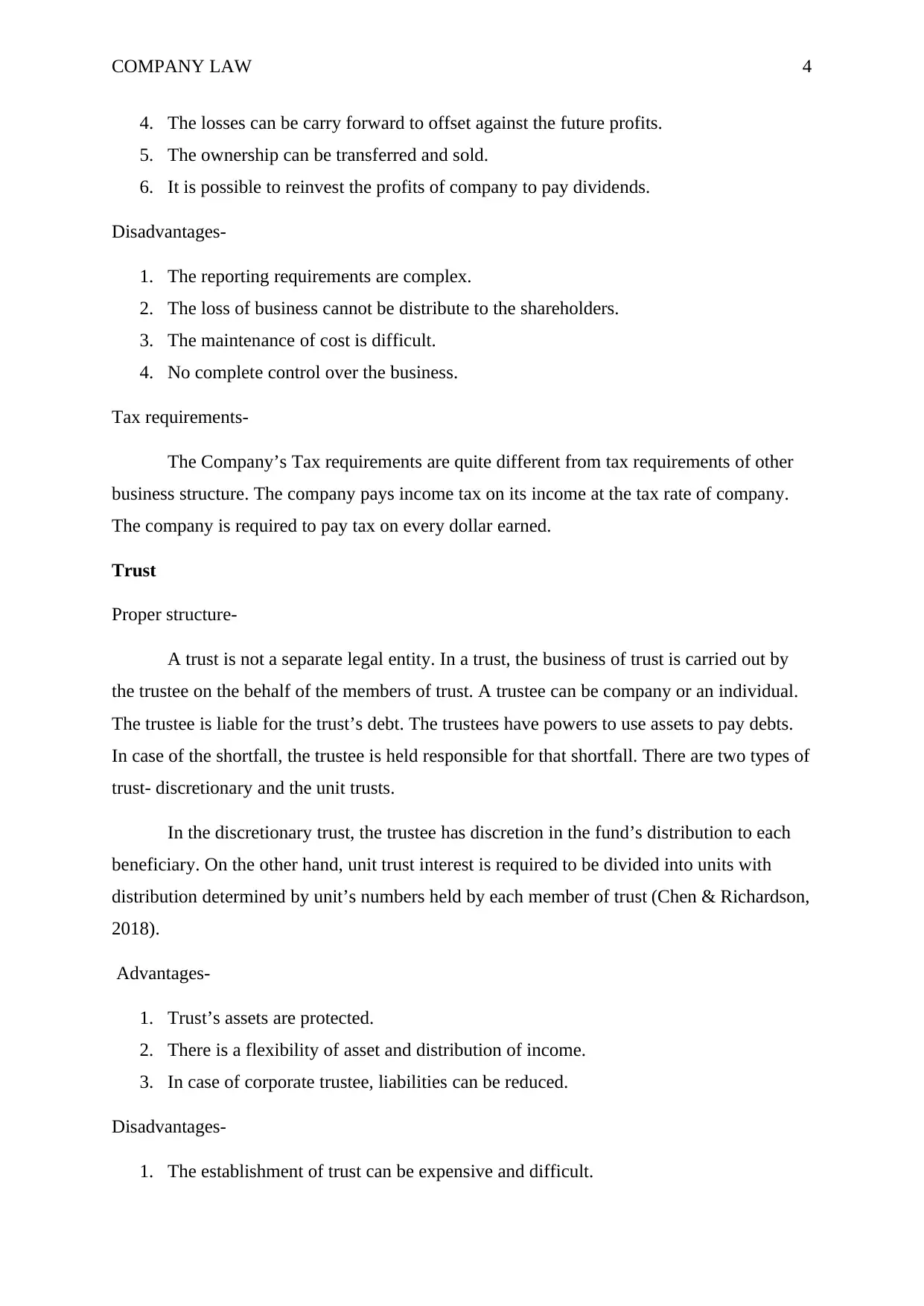
COMPANY LAW 4
4. The losses can be carry forward to offset against the future profits.
5. The ownership can be transferred and sold.
6. It is possible to reinvest the profits of company to pay dividends.
Disadvantages-
1. The reporting requirements are complex.
2. The loss of business cannot be distribute to the shareholders.
3. The maintenance of cost is difficult.
4. No complete control over the business.
Tax requirements-
The Company’s Tax requirements are quite different from tax requirements of other
business structure. The company pays income tax on its income at the tax rate of company.
The company is required to pay tax on every dollar earned.
Trust
Proper structure-
A trust is not a separate legal entity. In a trust, the business of trust is carried out by
the trustee on the behalf of the members of trust. A trustee can be company or an individual.
The trustee is liable for the trust’s debt. The trustees have powers to use assets to pay debts.
In case of the shortfall, the trustee is held responsible for that shortfall. There are two types of
trust- discretionary and the unit trusts.
In the discretionary trust, the trustee has discretion in the fund’s distribution to each
beneficiary. On the other hand, unit trust interest is required to be divided into units with
distribution determined by unit’s numbers held by each member of trust (Chen & Richardson,
2018).
Advantages-
1. Trust’s assets are protected.
2. There is a flexibility of asset and distribution of income.
3. In case of corporate trustee, liabilities can be reduced.
Disadvantages-
1. The establishment of trust can be expensive and difficult.
4. The losses can be carry forward to offset against the future profits.
5. The ownership can be transferred and sold.
6. It is possible to reinvest the profits of company to pay dividends.
Disadvantages-
1. The reporting requirements are complex.
2. The loss of business cannot be distribute to the shareholders.
3. The maintenance of cost is difficult.
4. No complete control over the business.
Tax requirements-
The Company’s Tax requirements are quite different from tax requirements of other
business structure. The company pays income tax on its income at the tax rate of company.
The company is required to pay tax on every dollar earned.
Trust
Proper structure-
A trust is not a separate legal entity. In a trust, the business of trust is carried out by
the trustee on the behalf of the members of trust. A trustee can be company or an individual.
The trustee is liable for the trust’s debt. The trustees have powers to use assets to pay debts.
In case of the shortfall, the trustee is held responsible for that shortfall. There are two types of
trust- discretionary and the unit trusts.
In the discretionary trust, the trustee has discretion in the fund’s distribution to each
beneficiary. On the other hand, unit trust interest is required to be divided into units with
distribution determined by unit’s numbers held by each member of trust (Chen & Richardson,
2018).
Advantages-
1. Trust’s assets are protected.
2. There is a flexibility of asset and distribution of income.
3. In case of corporate trustee, liabilities can be reduced.
Disadvantages-
1. The establishment of trust can be expensive and difficult.
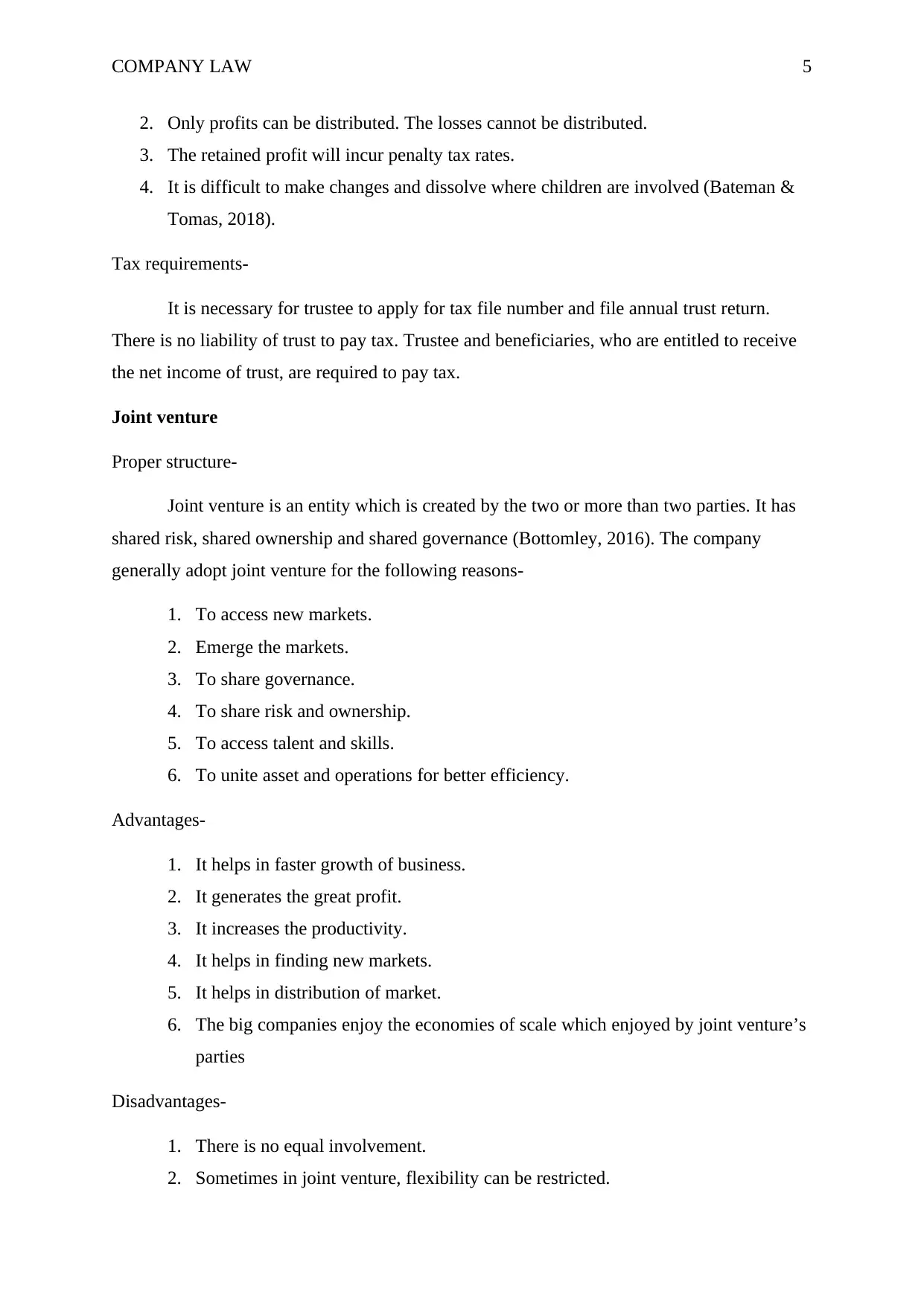
COMPANY LAW 5
2. Only profits can be distributed. The losses cannot be distributed.
3. The retained profit will incur penalty tax rates.
4. It is difficult to make changes and dissolve where children are involved (Bateman &
Tomas, 2018).
Tax requirements-
It is necessary for trustee to apply for tax file number and file annual trust return.
There is no liability of trust to pay tax. Trustee and beneficiaries, who are entitled to receive
the net income of trust, are required to pay tax.
Joint venture
Proper structure-
Joint venture is an entity which is created by the two or more than two parties. It has
shared risk, shared ownership and shared governance (Bottomley, 2016). The company
generally adopt joint venture for the following reasons-
1. To access new markets.
2. Emerge the markets.
3. To share governance.
4. To share risk and ownership.
5. To access talent and skills.
6. To unite asset and operations for better efficiency.
Advantages-
1. It helps in faster growth of business.
2. It generates the great profit.
3. It increases the productivity.
4. It helps in finding new markets.
5. It helps in distribution of market.
6. The big companies enjoy the economies of scale which enjoyed by joint venture’s
parties
Disadvantages-
1. There is no equal involvement.
2. Sometimes in joint venture, flexibility can be restricted.
2. Only profits can be distributed. The losses cannot be distributed.
3. The retained profit will incur penalty tax rates.
4. It is difficult to make changes and dissolve where children are involved (Bateman &
Tomas, 2018).
Tax requirements-
It is necessary for trustee to apply for tax file number and file annual trust return.
There is no liability of trust to pay tax. Trustee and beneficiaries, who are entitled to receive
the net income of trust, are required to pay tax.
Joint venture
Proper structure-
Joint venture is an entity which is created by the two or more than two parties. It has
shared risk, shared ownership and shared governance (Bottomley, 2016). The company
generally adopt joint venture for the following reasons-
1. To access new markets.
2. Emerge the markets.
3. To share governance.
4. To share risk and ownership.
5. To access talent and skills.
6. To unite asset and operations for better efficiency.
Advantages-
1. It helps in faster growth of business.
2. It generates the great profit.
3. It increases the productivity.
4. It helps in finding new markets.
5. It helps in distribution of market.
6. The big companies enjoy the economies of scale which enjoyed by joint venture’s
parties
Disadvantages-
1. There is no equal involvement.
2. Sometimes in joint venture, flexibility can be restricted.
⊘ This is a preview!⊘
Do you want full access?
Subscribe today to unlock all pages.

Trusted by 1+ million students worldwide
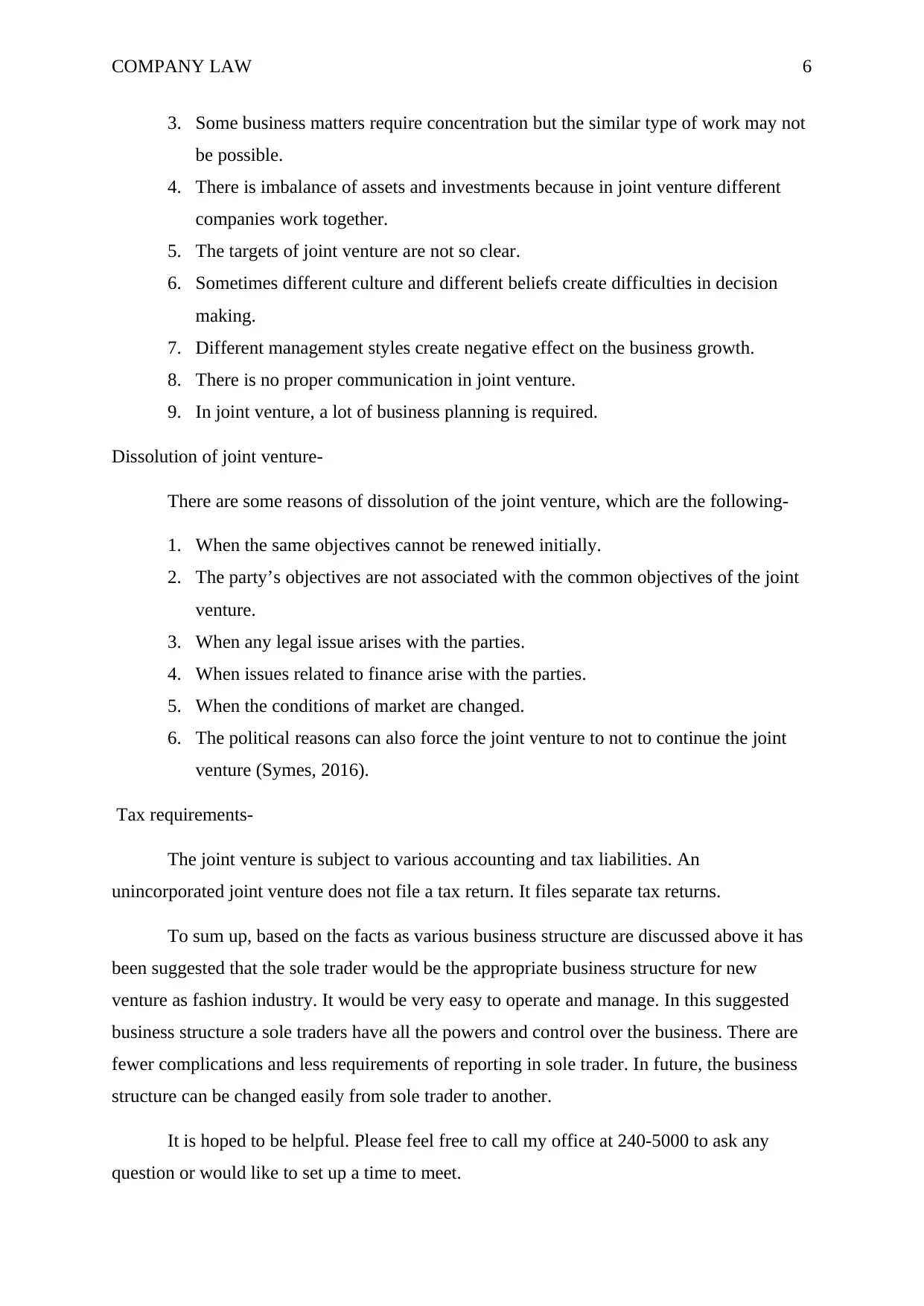
COMPANY LAW 6
3. Some business matters require concentration but the similar type of work may not
be possible.
4. There is imbalance of assets and investments because in joint venture different
companies work together.
5. The targets of joint venture are not so clear.
6. Sometimes different culture and different beliefs create difficulties in decision
making.
7. Different management styles create negative effect on the business growth.
8. There is no proper communication in joint venture.
9. In joint venture, a lot of business planning is required.
Dissolution of joint venture-
There are some reasons of dissolution of the joint venture, which are the following-
1. When the same objectives cannot be renewed initially.
2. The party’s objectives are not associated with the common objectives of the joint
venture.
3. When any legal issue arises with the parties.
4. When issues related to finance arise with the parties.
5. When the conditions of market are changed.
6. The political reasons can also force the joint venture to not to continue the joint
venture (Symes, 2016).
Tax requirements-
The joint venture is subject to various accounting and tax liabilities. An
unincorporated joint venture does not file a tax return. It files separate tax returns.
To sum up, based on the facts as various business structure are discussed above it has
been suggested that the sole trader would be the appropriate business structure for new
venture as fashion industry. It would be very easy to operate and manage. In this suggested
business structure a sole traders have all the powers and control over the business. There are
fewer complications and less requirements of reporting in sole trader. In future, the business
structure can be changed easily from sole trader to another.
It is hoped to be helpful. Please feel free to call my office at 240-5000 to ask any
question or would like to set up a time to meet.
3. Some business matters require concentration but the similar type of work may not
be possible.
4. There is imbalance of assets and investments because in joint venture different
companies work together.
5. The targets of joint venture are not so clear.
6. Sometimes different culture and different beliefs create difficulties in decision
making.
7. Different management styles create negative effect on the business growth.
8. There is no proper communication in joint venture.
9. In joint venture, a lot of business planning is required.
Dissolution of joint venture-
There are some reasons of dissolution of the joint venture, which are the following-
1. When the same objectives cannot be renewed initially.
2. The party’s objectives are not associated with the common objectives of the joint
venture.
3. When any legal issue arises with the parties.
4. When issues related to finance arise with the parties.
5. When the conditions of market are changed.
6. The political reasons can also force the joint venture to not to continue the joint
venture (Symes, 2016).
Tax requirements-
The joint venture is subject to various accounting and tax liabilities. An
unincorporated joint venture does not file a tax return. It files separate tax returns.
To sum up, based on the facts as various business structure are discussed above it has
been suggested that the sole trader would be the appropriate business structure for new
venture as fashion industry. It would be very easy to operate and manage. In this suggested
business structure a sole traders have all the powers and control over the business. There are
fewer complications and less requirements of reporting in sole trader. In future, the business
structure can be changed easily from sole trader to another.
It is hoped to be helpful. Please feel free to call my office at 240-5000 to ask any
question or would like to set up a time to meet.
Paraphrase This Document
Need a fresh take? Get an instant paraphrase of this document with our AI Paraphraser

COMPANY LAW 7
Best Regards,
Jimmi Ley
Enclosures
CC:
Best Regards,
Jimmi Ley
Enclosures
CC:
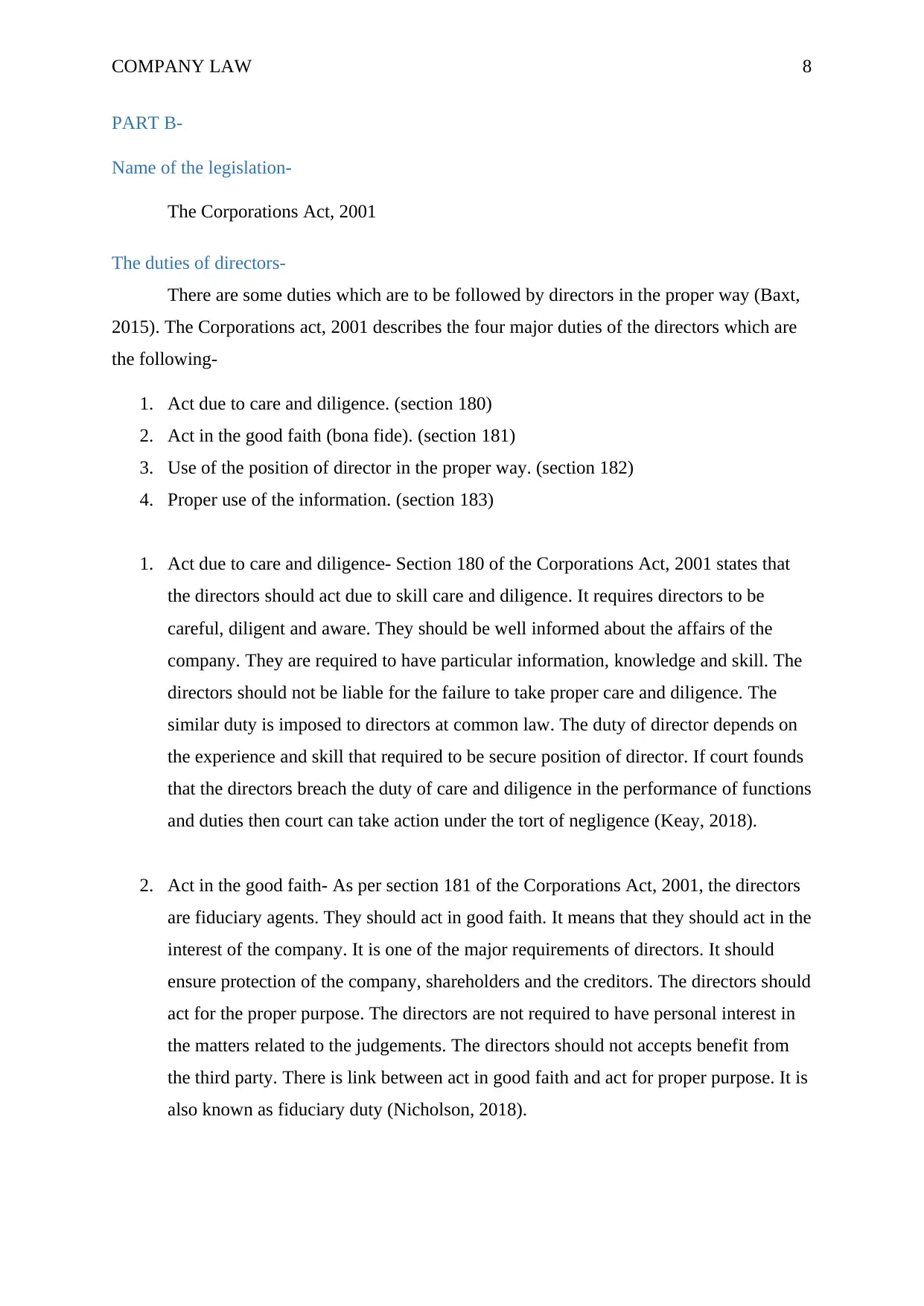
COMPANY LAW 8
PART B-
Name of the legislation-
The Corporations Act, 2001
The duties of directors-
There are some duties which are to be followed by directors in the proper way (Baxt,
2015). The Corporations act, 2001 describes the four major duties of the directors which are
the following-
1. Act due to care and diligence. (section 180)
2. Act in the good faith (bona fide). (section 181)
3. Use of the position of director in the proper way. (section 182)
4. Proper use of the information. (section 183)
1. Act due to care and diligence- Section 180 of the Corporations Act, 2001 states that
the directors should act due to skill care and diligence. It requires directors to be
careful, diligent and aware. They should be well informed about the affairs of the
company. They are required to have particular information, knowledge and skill. The
directors should not be liable for the failure to take proper care and diligence. The
similar duty is imposed to directors at common law. The duty of director depends on
the experience and skill that required to be secure position of director. If court founds
that the directors breach the duty of care and diligence in the performance of functions
and duties then court can take action under the tort of negligence (Keay, 2018).
2. Act in the good faith- As per section 181 of the Corporations Act, 2001, the directors
are fiduciary agents. They should act in good faith. It means that they should act in the
interest of the company. It is one of the major requirements of directors. It should
ensure protection of the company, shareholders and the creditors. The directors should
act for the proper purpose. The directors are not required to have personal interest in
the matters related to the judgements. The directors should not accepts benefit from
the third party. There is link between act in good faith and act for proper purpose. It is
also known as fiduciary duty (Nicholson, 2018).
PART B-
Name of the legislation-
The Corporations Act, 2001
The duties of directors-
There are some duties which are to be followed by directors in the proper way (Baxt,
2015). The Corporations act, 2001 describes the four major duties of the directors which are
the following-
1. Act due to care and diligence. (section 180)
2. Act in the good faith (bona fide). (section 181)
3. Use of the position of director in the proper way. (section 182)
4. Proper use of the information. (section 183)
1. Act due to care and diligence- Section 180 of the Corporations Act, 2001 states that
the directors should act due to skill care and diligence. It requires directors to be
careful, diligent and aware. They should be well informed about the affairs of the
company. They are required to have particular information, knowledge and skill. The
directors should not be liable for the failure to take proper care and diligence. The
similar duty is imposed to directors at common law. The duty of director depends on
the experience and skill that required to be secure position of director. If court founds
that the directors breach the duty of care and diligence in the performance of functions
and duties then court can take action under the tort of negligence (Keay, 2018).
2. Act in the good faith- As per section 181 of the Corporations Act, 2001, the directors
are fiduciary agents. They should act in good faith. It means that they should act in the
interest of the company. It is one of the major requirements of directors. It should
ensure protection of the company, shareholders and the creditors. The directors should
act for the proper purpose. The directors are not required to have personal interest in
the matters related to the judgements. The directors should not accepts benefit from
the third party. There is link between act in good faith and act for proper purpose. It is
also known as fiduciary duty (Nicholson, 2018).
⊘ This is a preview!⊘
Do you want full access?
Subscribe today to unlock all pages.

Trusted by 1+ million students worldwide
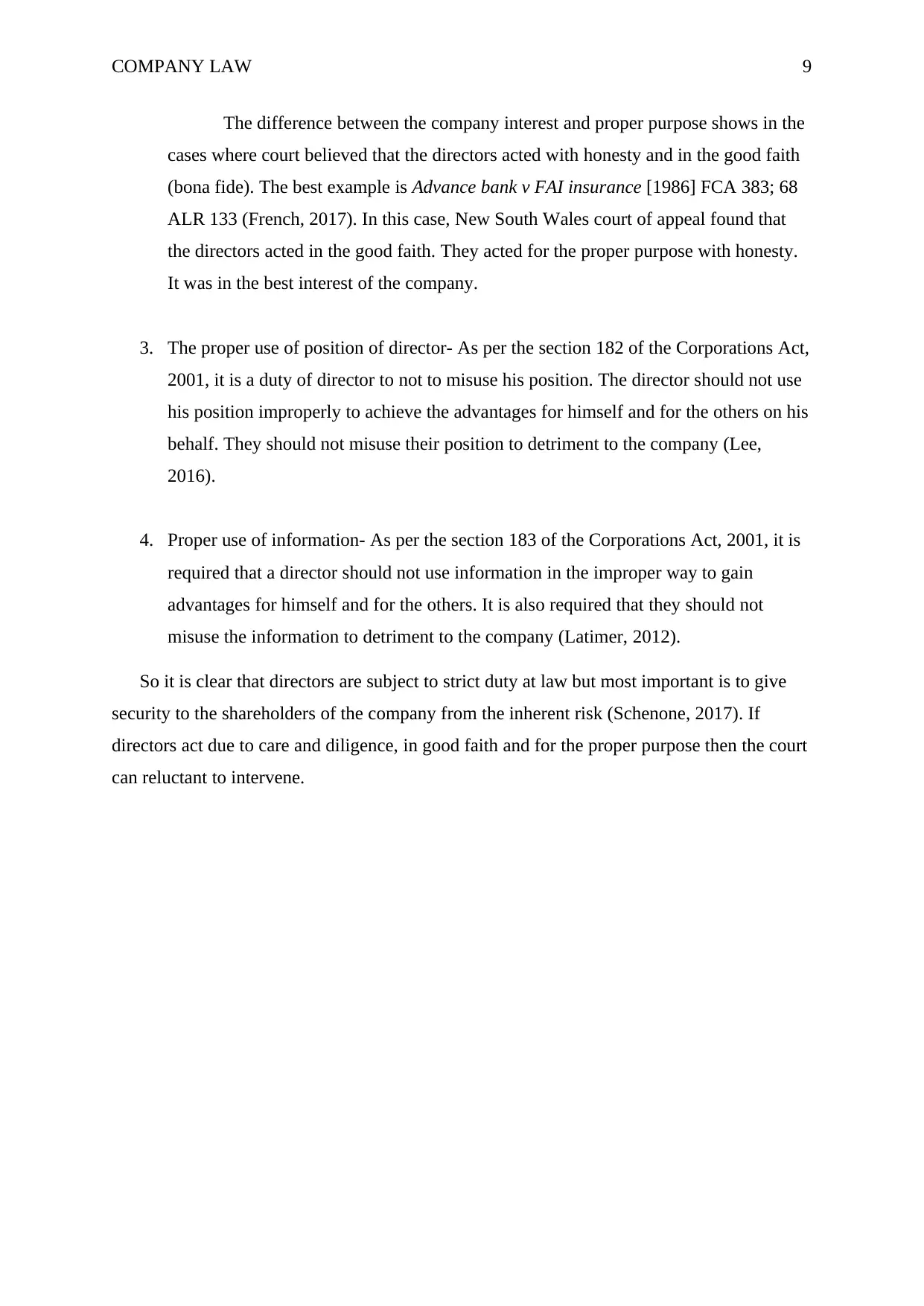
COMPANY LAW 9
The difference between the company interest and proper purpose shows in the
cases where court believed that the directors acted with honesty and in the good faith
(bona fide). The best example is Advance bank v FAI insurance [1986] FCA 383; 68
ALR 133 (French, 2017). In this case, New South Wales court of appeal found that
the directors acted in the good faith. They acted for the proper purpose with honesty.
It was in the best interest of the company.
3. The proper use of position of director- As per the section 182 of the Corporations Act,
2001, it is a duty of director to not to misuse his position. The director should not use
his position improperly to achieve the advantages for himself and for the others on his
behalf. They should not misuse their position to detriment to the company (Lee,
2016).
4. Proper use of information- As per the section 183 of the Corporations Act, 2001, it is
required that a director should not use information in the improper way to gain
advantages for himself and for the others. It is also required that they should not
misuse the information to detriment to the company (Latimer, 2012).
So it is clear that directors are subject to strict duty at law but most important is to give
security to the shareholders of the company from the inherent risk (Schenone, 2017). If
directors act due to care and diligence, in good faith and for the proper purpose then the court
can reluctant to intervene.
The difference between the company interest and proper purpose shows in the
cases where court believed that the directors acted with honesty and in the good faith
(bona fide). The best example is Advance bank v FAI insurance [1986] FCA 383; 68
ALR 133 (French, 2017). In this case, New South Wales court of appeal found that
the directors acted in the good faith. They acted for the proper purpose with honesty.
It was in the best interest of the company.
3. The proper use of position of director- As per the section 182 of the Corporations Act,
2001, it is a duty of director to not to misuse his position. The director should not use
his position improperly to achieve the advantages for himself and for the others on his
behalf. They should not misuse their position to detriment to the company (Lee,
2016).
4. Proper use of information- As per the section 183 of the Corporations Act, 2001, it is
required that a director should not use information in the improper way to gain
advantages for himself and for the others. It is also required that they should not
misuse the information to detriment to the company (Latimer, 2012).
So it is clear that directors are subject to strict duty at law but most important is to give
security to the shareholders of the company from the inherent risk (Schenone, 2017). If
directors act due to care and diligence, in good faith and for the proper purpose then the court
can reluctant to intervene.
Paraphrase This Document
Need a fresh take? Get an instant paraphrase of this document with our AI Paraphraser
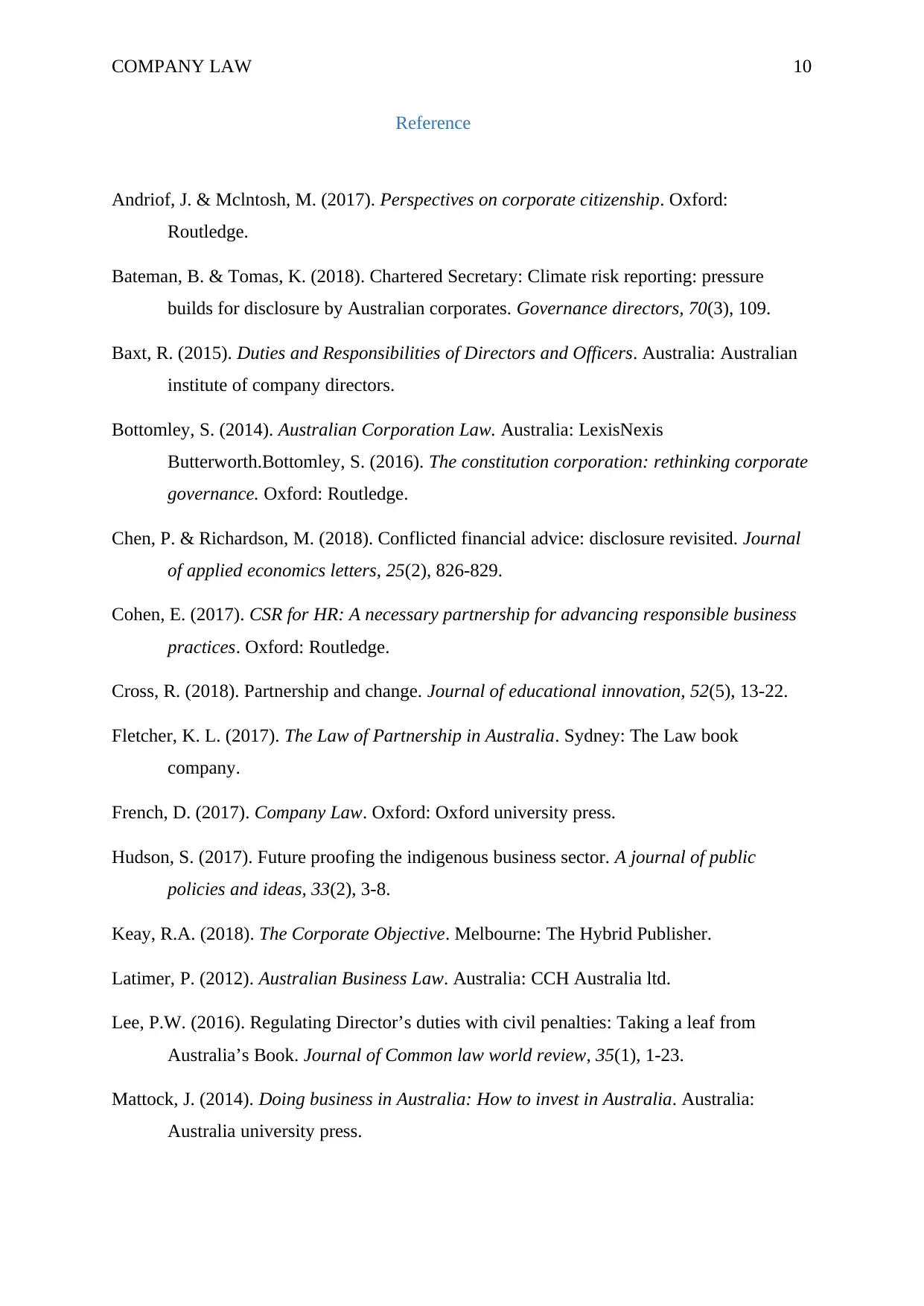
COMPANY LAW 10
Reference
Andriof, J. & Mclntosh, M. (2017). Perspectives on corporate citizenship. Oxford:
Routledge.
Bateman, B. & Tomas, K. (2018). Chartered Secretary: Climate risk reporting: pressure
builds for disclosure by Australian corporates. Governance directors, 70(3), 109.
Baxt, R. (2015). Duties and Responsibilities of Directors and Officers. Australia: Australian
institute of company directors.
Bottomley, S. (2014). Australian Corporation Law. Australia: LexisNexis
Butterworth.Bottomley, S. (2016). The constitution corporation: rethinking corporate
governance. Oxford: Routledge.
Chen, P. & Richardson, M. (2018). Conflicted financial advice: disclosure revisited. Journal
of applied economics letters, 25(2), 826-829.
Cohen, E. (2017). CSR for HR: A necessary partnership for advancing responsible business
practices. Oxford: Routledge.
Cross, R. (2018). Partnership and change. Journal of educational innovation, 52(5), 13-22.
Fletcher, K. L. (2017). The Law of Partnership in Australia. Sydney: The Law book
company.
French, D. (2017). Company Law. Oxford: Oxford university press.
Hudson, S. (2017). Future proofing the indigenous business sector. A journal of public
policies and ideas, 33(2), 3-8.
Keay, R.A. (2018). The Corporate Objective. Melbourne: The Hybrid Publisher.
Latimer, P. (2012). Australian Business Law. Australia: CCH Australia ltd.
Lee, P.W. (2016). Regulating Director’s duties with civil penalties: Taking a leaf from
Australia’s Book. Journal of Common law world review, 35(1), 1-23.
Mattock, J. (2014). Doing business in Australia: How to invest in Australia. Australia:
Australia university press.
Reference
Andriof, J. & Mclntosh, M. (2017). Perspectives on corporate citizenship. Oxford:
Routledge.
Bateman, B. & Tomas, K. (2018). Chartered Secretary: Climate risk reporting: pressure
builds for disclosure by Australian corporates. Governance directors, 70(3), 109.
Baxt, R. (2015). Duties and Responsibilities of Directors and Officers. Australia: Australian
institute of company directors.
Bottomley, S. (2014). Australian Corporation Law. Australia: LexisNexis
Butterworth.Bottomley, S. (2016). The constitution corporation: rethinking corporate
governance. Oxford: Routledge.
Chen, P. & Richardson, M. (2018). Conflicted financial advice: disclosure revisited. Journal
of applied economics letters, 25(2), 826-829.
Cohen, E. (2017). CSR for HR: A necessary partnership for advancing responsible business
practices. Oxford: Routledge.
Cross, R. (2018). Partnership and change. Journal of educational innovation, 52(5), 13-22.
Fletcher, K. L. (2017). The Law of Partnership in Australia. Sydney: The Law book
company.
French, D. (2017). Company Law. Oxford: Oxford university press.
Hudson, S. (2017). Future proofing the indigenous business sector. A journal of public
policies and ideas, 33(2), 3-8.
Keay, R.A. (2018). The Corporate Objective. Melbourne: The Hybrid Publisher.
Latimer, P. (2012). Australian Business Law. Australia: CCH Australia ltd.
Lee, P.W. (2016). Regulating Director’s duties with civil penalties: Taking a leaf from
Australia’s Book. Journal of Common law world review, 35(1), 1-23.
Mattock, J. (2014). Doing business in Australia: How to invest in Australia. Australia:
Australia university press.
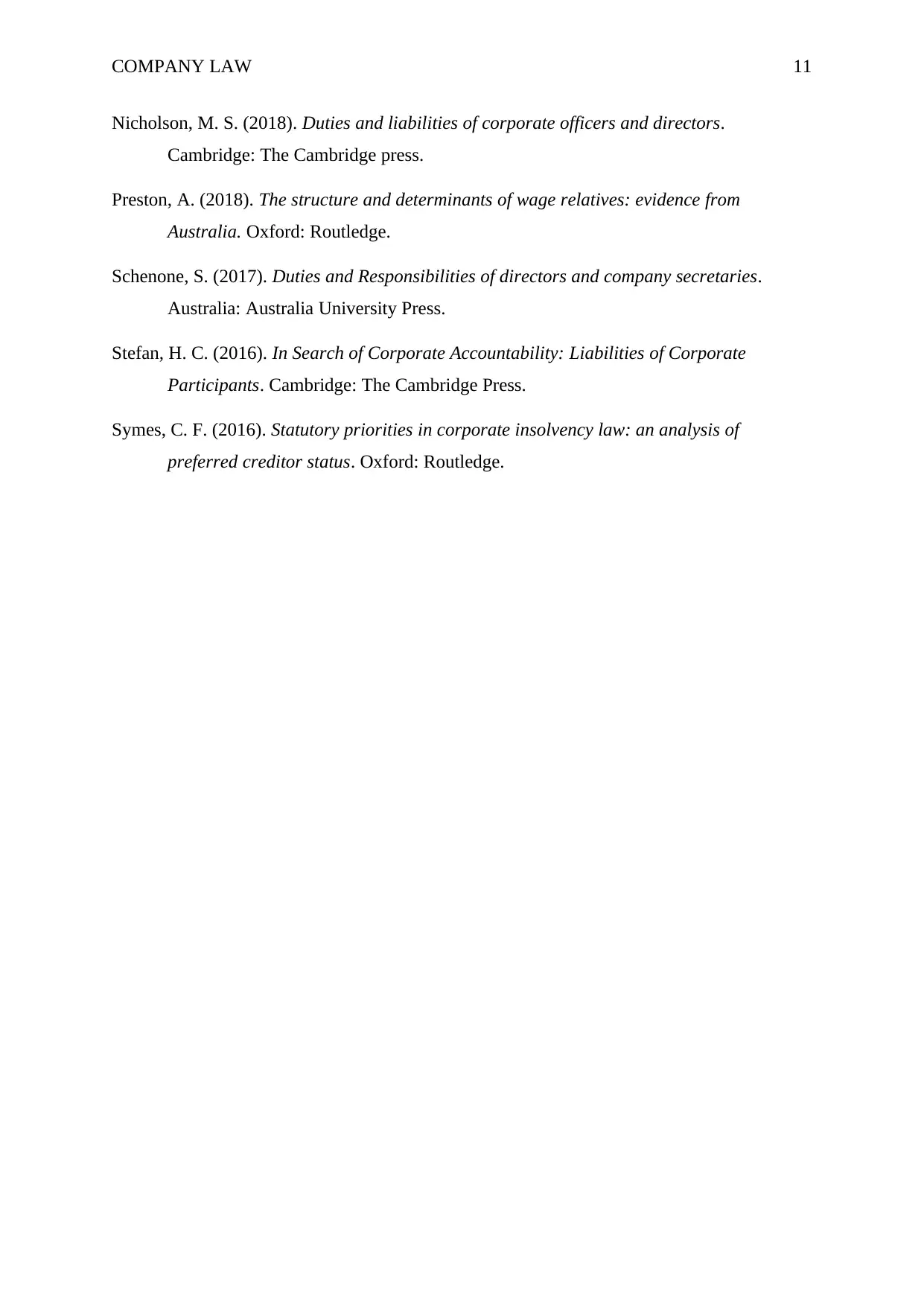
COMPANY LAW 11
Nicholson, M. S. (2018). Duties and liabilities of corporate officers and directors.
Cambridge: The Cambridge press.
Preston, A. (2018). The structure and determinants of wage relatives: evidence from
Australia. Oxford: Routledge.
Schenone, S. (2017). Duties and Responsibilities of directors and company secretaries.
Australia: Australia University Press.
Stefan, H. C. (2016). In Search of Corporate Accountability: Liabilities of Corporate
Participants. Cambridge: The Cambridge Press.
Symes, C. F. (2016). Statutory priorities in corporate insolvency law: an analysis of
preferred creditor status. Oxford: Routledge.
Nicholson, M. S. (2018). Duties and liabilities of corporate officers and directors.
Cambridge: The Cambridge press.
Preston, A. (2018). The structure and determinants of wage relatives: evidence from
Australia. Oxford: Routledge.
Schenone, S. (2017). Duties and Responsibilities of directors and company secretaries.
Australia: Australia University Press.
Stefan, H. C. (2016). In Search of Corporate Accountability: Liabilities of Corporate
Participants. Cambridge: The Cambridge Press.
Symes, C. F. (2016). Statutory priorities in corporate insolvency law: an analysis of
preferred creditor status. Oxford: Routledge.
⊘ This is a preview!⊘
Do you want full access?
Subscribe today to unlock all pages.

Trusted by 1+ million students worldwide
1 out of 14
Related Documents
Your All-in-One AI-Powered Toolkit for Academic Success.
+13062052269
info@desklib.com
Available 24*7 on WhatsApp / Email
![[object Object]](/_next/static/media/star-bottom.7253800d.svg)
Unlock your academic potential
Copyright © 2020–2025 A2Z Services. All Rights Reserved. Developed and managed by ZUCOL.




